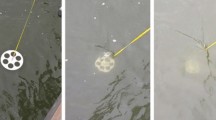Abstract
We present a general methodology for evaluating the capabilities of a general lidar system encompassing both backscatter (elastic and Raman lidar) and topographic targets. By introducing a well-defined atmospheric reference medium and by individually examining and decomposing the contributions of lidar system parameters including lidar transmitter power, field of view, receiver noise, atmospheric conditions, and sky background on the signal-to-noise ratio, we obtain a simple dimensionless parameterization of the lidar system. Using this parameterization, numerical simulations are carried out to determine achievable lidar performance including operation range, minimum detectable gas concentration, and so on.
Similar content being viewed by others
References
W. Grant, E. Browell, R. Menzies, K. Sassen, C.-Y. She, B. Thompson (eds.), Selected Papers on Laser Applications in Remote Sensing. SPIE Milestone Series, vol. MS 141 (SPIE, Bellingham, 1997), pp. 13–34, 142–177, 246–332, 511–526
G. Kamerman, B. Thompson (eds.), Selected Papers on Laser Radar. SPIE Milestone Series, vol. MS 133 (SPIE, Bellingham, 1997), pp. 525–708
V. Zuev, M. Kataev, M. Makogon, A. Mitsel, Atmos. Ocean. Opt. 8(8), 1136 (1995)
U. Singh, T. Itabe, Z. Liu (eds.), Lidar remote sensing for industry and environment monitoring. Proc. SPIE 4893, 1–24, 121–159 (2003)
M. Sigrist (ed.), Air Monitoring by Spectroscopic Techniques (Wiley, New York, 1994)
J. Bosenberg, D. Brassington, P. Simon (eds.), Instrument Development for Atmospheric Research and Monitoring: Lidar Profiling, DOAS and TDLS (Springer, Berlin, 1997)
V.A. Kovalev, W.E. Eichinger, Elastic Lidar: Theory, Practice, and Analysis Methods (Wiley-Interscience, New York, 2004)
D.K. Killinger, Lidar and Laser Remote Sensing: Handbook of Vibrational Spectroscopy (Wiley, New York, 2002)
K. Schaefer, O. Lado-Bordowsky, A. Comeron, R. Picard (eds.), Remote sensing of clouds and the atmosphere. Proc. SPIE 4882, 400–450 (2003)
G.R. Osche, Optical Detection Theory for Laser Applications (Wiley, New York, 2002)
R.M. Measures, Laser Remote Sensing: Fundamentals and Applications (Wiley, New York, 1994)
R.R. Agishev, Protection from Background Clutter in Electro-Optical Systems of Atmosphere Monitoring (Mashinostroenie, Moscow, 1994) [in Russian]
R.R. Agishev, A. Comeron, Appl. Opt. 41(36), 7516 (2002)
R.R. Agishev, A. Comeron, B. Gross, F. Moshary, S. Ahmed, A. Gilerson, V.A. Vlasov, Appl. Phys. B 79(2), 255 (2004)
A. Utkin, A. Lavrov, L. Costa, F. Simoes, R. Vilar, Appl. Phys. B 74, 77 (2002)
J.R. Campbell, E.J. Welton, J.D. Spinhirne, Q. Ji, S.-C. Tsay, S. Piketh, M. Barenbrug, B. Holben, J. Geophys. Res. 108, 847 (2003)
Author information
Authors and Affiliations
Corresponding author
Rights and permissions
About this article
Cite this article
Agishev, R., Gross, B., Moshary, F. et al. Development of a SNR parameterization scheme for general lidar assessment. Appl. Phys. B 80, 765–776 (2005). https://doi.org/10.1007/s00340-005-1783-8
Received:
Revised:
Published:
Issue Date:
DOI: https://doi.org/10.1007/s00340-005-1783-8




